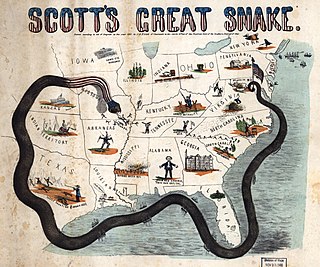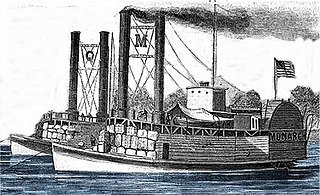USS Noble (1861) was a wooden bark purchased during the American Civil War by the Union Navy 2 December 1861 at Sag Harbor, New York.
Noble was selected to be used as part of the obstructions placed in the "Stone Fleet" – a fleet of hulks sunk in selected waterways of the Confederate States of America to prevent passage of ships.
She was sunk in a channel leading to Savannah, Georgia, early in 1862.

CSS Oregon was a wooden sidewheel steamer that served as a gunboat in the Confederate States Army during the American Civil War. Built in 1846 for the Mobile Mail Line, she transported mail between New Orleans, Louisiana, and Mobile, Alabama, before the war. In 1861, she was seized by the Governor of Louisiana, Thomas Overton Moore, and served as a blockade runner before being selected for use by the Confederate Army. After transferring men and supplies to Ship Island, she was formally converted into a gunboat and armed with four cannon. Remaining behind on Lake Pontchartrain when many Confederate warships were transferred up the Mississippi River, Oregon served in the Mississippi Sound and Pass Christian areas. She took part in several minor actions involving USS New London, two of which resulted in the Confederates moving into shallow water to avoid close-range action, and the third ending when the Confederate ships abandoned the Pass Christian area. In April 1862, Union pressure confined her and other Confederate ships to Lake Pontchartrain. Later that month, with Union forces closing in on New Orleans, Oregon was sunk as a blockship. Her wreck was removed and destroyed in the early 1870s.
The second USS Potomac was an old whaler the United States Navy purchased on 1 November 1861. She was a part of the "Stone Fleet," a group of ships used to block the entrances to Confederate harbors during the American Civil War, and was sunk for this purpose on 9 January 1862.
The Stone Fleet consisted of a fleet of aging ships purchased in New Bedford and other New England ports, loaded with stone, and sailed south during the American Civil War by the Union Navy for use as blockships. They were to be deliberately sunk at the entrance of Charleston Harbor, South Carolina in the hope of obstructing blockade runners, then supplying Confederate interests. Although some sank along the way and others were sunk near Tybee Island, Georgia, to serve as breakwaters, wharves for the landing of Union troops, the majority were divided into two lesser fleets. One fleet was sunk to block the south channel off Morris Island, and the other to block the north channel near Rattlesnake Shoals off the present day Isle of Palms in what proved to be failed efforts to block access the main shipping channels into Charleston Harbor.

The Union blockade in the American Civil War was a naval strategy by the United States to prevent the Confederacy from trading.

USS Monarch was a United States Army sidewheel ram that saw service in the American Civil War as part of the United States Ram Fleet and the Mississippi Marine Brigade. She operated on the Mississippi River and Yazoo River during 1862 and 1863.
USS Rebecca Sims was built as a general trading ship in 1801 by Samuel Bowers of Philadelphia, Pennsylvania, for Joseph Sims.
USS Tenedos, abark of 245 tons, 300 feet (91 m) long, was originally a Pacific whaler, owned by Lawrence and Company of New London, Connecticut. During the American Civil War, the United States Navy purchased her on 16 October 1861 for use in the "Stone Fleet," a group of ships to be sunk as obstructions along the coast of the Confederate States of America. Under the command of Master O. Sisson, she was sunk as blockship in Charleston Harbor off Charleston, South Carolina, on 19 or 20 December 1861.
USS Robin Hood was a 400-foot-long (120 m) ship of 395 tons, purchased by the United States Navy in Mystic, Connecticut, during the American Civil War on 20 October 1861 for use in the "Stone Fleet." In December 1861 she was sunk as an obstruction in Charleston Harbor off Charleston, South Carolina.
USS South America (1861) was a whaler purchased by the Union Navy on 9 November 1861 at New London, Connecticut. She was acquired to be sunk as an obstruction in the channel leading to a Confederate port as part of the Union blockade on ports and waterways of the Confederate States of America.
USS Amazon was a wooden-hulled bark of 318 tons that had previously sailed as a whaler out of Fairhaven, Massachusetts.
USS Peri was one of the ships of the Stone Fleet, sunk in the harbor of Charleston, South Carolina as a blockade during the American Civil War.
The Phoenix was a 404-ton American wooden whaler based in New London, Connecticut. The Union Navy purchased Phoenix at New London on 9 November 1861, at the start of the American Civil War. The Navy wanted her for the Stone Fleet, a group of vessels to be sunk in the channels of important Southern harbors to interrupt Confederate trade. She sailed on the 20th but grounded while crossing Savannah Bar, lost her rudder, and began leaking badly. When refloated she was beached as a breakwater to shelter Union troops landing on Tybee Island, Georgia, on or before 5 December 1861, in preparation for the Battle of Fort Pulaski.
USS Timor was purchased at Sag Harbor, New York on 30 October 1861. She was sunk as part of the Stone Fleet at Maffitts channel in Charleston harbor on 25 or 26 January 1862.
USS Stephen Young was one of the ships of the Stone Fleet, sunk in the harbor of Charleston, South Carolina to be used as a blockade during the American Civil War.
USS Valparaiso was a Navy vessel that was given a "second life" in her nautical career. During the start of the American Civil War, she was destined to be used as a "stone ship" hazard to navigation sunk in a Southern harbor, but the Union Navy reconsidered and put her to work as a stores ship, supporting the blockade of the ports of the Confederate States of America.

USS Maria J. Carlton was a schooner acquired by the United States Navy on October 15, 1861, during the American Civil War. Built before the war, the vessel was converted into a mortar schooner by the Navy. She was then transferred to the mouth of the Mississippi River in early 1862, as part of a force tasked with neutralizing Confederate forts guarding New Orleans, Louisiana. Maria J. Carlton participated in the Battle of Forts Jackson and St. Philip on April 18, but, the battle continuing, was sunk the next day by a shot from Fort Jackson. She was the only Union warship sunk solely by artillery fire from Confederate forts on the Mississippi River during the war.
USS Hero (1861), a wooden schooner, was purchased by the Union Navy during the American Civil War at Baltimore, Maryland, 13 August 1861 to obstruct inlets to Pamlico Sound, North Carolina, near Cape Hatteras.
USS Orion (1861), a wooden schooner, was purchased by the Union Navy during the American Civil War at Baltimore, Maryland, on 13 August 1861.
USS South Wind (1861) was a schooner purchased by the Union Navy on 13 August 1861 at Baltimore, Maryland, for the "Stone Fleet" of American Civil War fame.
CSS Carondelet was a sidewheel steamer that served in the Confederate States Navy during the American Civil War. Construction for the vessel started in 1861, and she was launched on January 25, 1862, and commissioned on March 16. Her sister ship was CSS Bienville. On April 4, Carondelet, along with CSS Oregon and CSS Pamlico, took part in a small naval action near Pass Christian against USS New London, USS John P. Jackson, and the troop transport USS Henry Lewis. Carondelet suffered damage to her wheel during the fight, and likely fired the only two shots that struck John P. Jackson. Later that month, with the Confederates abandoning New Orleans, Louisiana, Carondelet was scuttled by her crew in either Lake Pontchartrain, the Tchefuncte River, or the Bogue Falaya River.